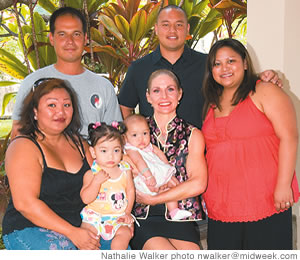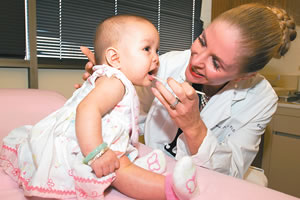Reconstructing Children’s Lives
Interviewed by Melissa Moniz
Wednesday - June 11, 2008
E-mail this story | Print this page | Comments (0) | Archive
 Del.icio.us Share
Del.icio.us Share

Dr. Barbera Honnebier
Plastic & Reconstructive Surgeon
Can you talk about your background?
My educational background is idiosyncratic because I was born and raised in Amsterdam, the Netherlands. I have an M.D. from the University of Amsterdam and came to the U.S. in 1987 on a research scholarship. In 1994, I obtained my Ph.D. from Cornell. This was 15 years ago, and being a foreign medical graduate was not easy, especially if you wanted to get into surgery. So I took a three-month leave of absence from Cornell to complete all the required U.S. examinations, and was accepted by UCLA with advanced standing. So in two years I received an M.D. from UCLA in 1996. This allowed me to pursue surgical training. I matched here (University of Hawaii) for general surgery. During my five years here, I recognized a tremendous need in my areas of interest. So I went back to the Mainland and did three fellowships: plastic and reconstructive surgery, hand and micro, and then cranio-maxillo-facial surgery. Cranio-maxillo-facial surgery is a very unique field of plastic surgery that really focuses on congenital deformities of the head and neck area, especially in children, but also on trauma and adults. At present, I am the only and first-ever cranio-facial specialist in Hawaii, and there aren’t very many of us because it’s a very close-knit society and there are maybe only a handful of women in the world who are trained in this. I do the majority of the cleft lip and palate surgeries in Hawaii - and we have a large cleft population here, which is what some people usually don’t realize. So that is my big thing. That is what I love the most about my presence here. Cranio-facial surgery extends from things such as cleft lip and palate, but it also involves children who are born with skull deformities, without a jaw, without ears. So that is my big, big passion and what I enjoy most. The kids are what I live for.
How long have you been at Queen’s?
I’ve been back as of August 2005. I trained here from 1996 to 2001.
How many of your patients are children?
I would say of my practice 25 percent is children, which also involves children with dog bites, trauma such as falling off the swing and breaking the jaw. The rest of my practice is a mixture of many things: facial trauma at Queen’s, other reconstructive challenges. I do a huge amount of breast reconstruction for women with breast cancer because I’m the only female plastic surgeon here. You can imagine, most women gravitate toward a woman to discuss issues of appearance, whether it’s after breast surgery or for body re-contouring. The children are my passion, but I couldn’t possibly have an office if I didn’t have all this other stuff.

|
Is cleft lip and palate the primary surgery that you do for children?
Yes, because cleft lip and palate rate is common: 1 in 500 births in Asian populations. Rates are similar here. We have about 17,000 births a year, I see anywhere from four to eight newborn clefts a month. To compare that to other races, the cleft rate in Caucasians is 1 in 1,200 births. In African-Americans it’s about 1 in 2,000 births, so by far Asian populations have a predisposition for cleft lip and palate.
This is why a lot of our missions are to Asian countries. Race is clear; next to that people are looking into folic acid deficiency and nutrition.
But let me clarify, there are two broad types of cleft lip and palate. There’s the child with isolated cleft lip and palate who is otherwise completely healthy and normal. Then there are children who have a syndrome or prenatal exposure who can also have a cleft lip and palate as well as other problems. Most children are otherwise completely normal but have a birth defect of cleft lip and/or palate. The degree of clefting determines the complexity of treatment as well as the outcome of therapy. If you have a cleft lip only, you can have a great operation at about 3 months of age after which you should be golden for the rest of your life. Methods we use nowadays leave minimal scar when done correctly. Joaquin Phoenix is a good example.
If you have a cleft palate, it opens up a huge Pandora’s Box, because if your palate is clefted you cannot swallow or speak properly, you are at risk for hearing loss as a result of chronic ear infections, and your teeth will not develop normally at the cleft site. Usually the nose is affected as well, so you will need a minimum of five operations, and the situation is much more complicated.

|
So what is the ideal time that a child with cleft lip or palate should receive surgery?
Generally speaking, lip repair is done at about 3 to 4 months of age, provided that the child has no other issues. It’s not so much the surgical risk, it’s the anesthesia risk because their respiratory center is not yet mature. Functionally, however, there is no real deadline for a cleft lip repair. That is not the case with the palate. Palate repair I would do as early as 10 months, but ideally before 21 months of age. That range has a lot to do with how the child is, whether the cleft is really wide or if there are other problems. Timing is critical for speech development. A palate repair after 5 years of age will never correct nasal speech because the brain is now entrained.
What advice would you give someone who is considering going into plastic surgery?
I often talk to medical students about this. Reconstructive surgery is the best specialty, as the goal is always to make things better and to add to people’s bodies, not take away from them. Surgical specialties have a concern of lifestyle.
I think the single most important advice you can give anybody is that if you really love it, it will all work out.
And I don’t think anyone really enjoys doing something that they are not good at. So you gravitate toward something that comes natural to you. I’ve been fixing things and putting things together for as long as I can remember. I am very lucky. Every single day I think I can put my talent into what I do professionally, so it’s very joyful. You have to first find out who you are and then you find your tool.
E-mail this story | Print this page | Comments (0) | Archive
Most Recent Comment(s):













